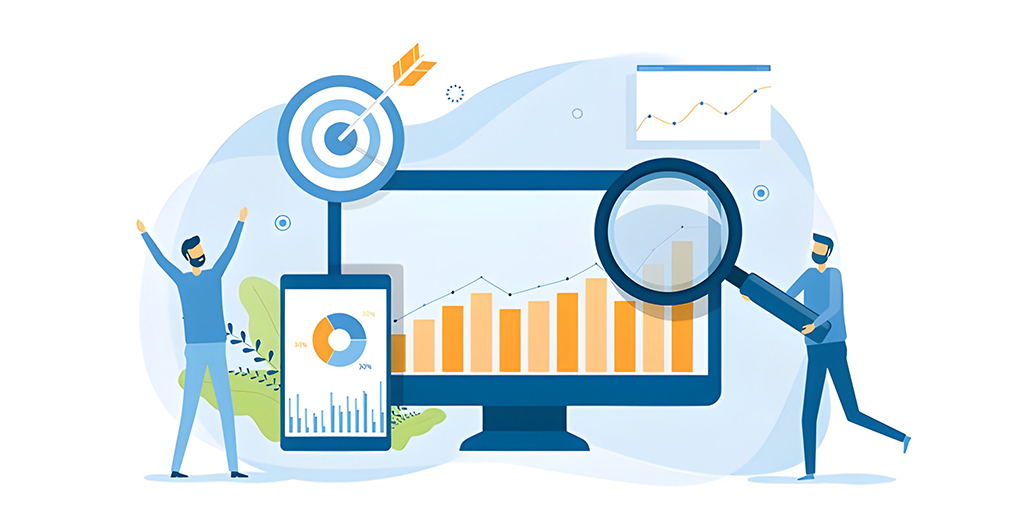Introduction
In today’s highly competitive digital landscape, businesses need more than just a presence online; they need to understand their audience, measure their efforts, and continually optimize their strategies. This is where digital marketing and web analytics intersect. By leveraging data-driven insights, businesses can create more effective marketing campaigns, enhance user experiences, and drive growth. This blog will explore the symbiotic relationship between digital marketing and web analytics and how they work together to achieve business success.
The Role of Digital Marketing
Digital marketing encompasses all marketing efforts that use the internet and electronic devices. It includes various tactics and strategies such as search engine optimization (SEO), content marketing, social media marketing, email marketing, pay-per-click (PPC) advertising, and more. The primary goal of digital marketing is to connect with potential customers where they spend much of their time online and to convert these interactions into meaningful engagements and sales.
Key components of digital marketing include:
- SEO: Optimizing your website to rank higher in search engine results pages (SERPs) to increase organic traffic.
- Content Marketing: producing and disseminating material that is valuable, pertinent, and consistent in order to draw in and hold the attention of a target audience.
- Social Media Marketing: Using social media channels to market your business, interact with your audience, and increase traffic to your website.
- Email Marketing: Sending targeted emails to prospects and customers to nurture relationships and drive conversions.
- PPC Advertising: Paying for ads on search engines, social media platforms, and other websites to drive immediate traffic and sales.
The Importance of Web Analytics
Web analytics collects, analyzes, and interprets data about website traffic and user behavior. It provides valuable insights into how visitors interact with your site, which marketing strategies are most effective, and where there are opportunities for improvement. By understanding these metrics, businesses can make informed decisions that enhance their digital marketing efforts and overall performance.
Key metrics tracked in web analytics include:
- Traffic Sources: Understanding where your visitors are coming from, whether organic search, social media, direct visits, or referral traffic.
- User Behavior: Analyzing how users navigate your site, which pages they visit, how long they stay, and what actions they take.
- Conversion Rates: Measuring the percentage of visitors who perform a desired action, such as making a purchase, completing a form, or subscribing to a newsletter.
- Bounce Rate: The percentage of visitors who leave your site after viewing only one page. A high bounce rate can indicate issues with site content or user experience.
- Engagement Metrics: Tracking page views, session duration, and interactions per visit to gauge how engaged your audience is with your content.
How Digital Marketing and Web Analytics Work Together
Integrating digital marketing and web analytics is essential for creating data-driven strategies that drive results. Here’s how they complement each other:
- Measuring Campaign Effectiveness:
- Tracking Performance: Web analytics tools, such as Google Analytics, allow marketers to track the performance of their campaigns in real time. This includes monitoring traffic sources, conversion rates, and ROI.
- Identifying Trends: By analyzing data, marketers can identify trends and patterns in user behavior. This helps in understanding which strategies are working and which need adjustments.
- Optimizing User Experience:
- Improving Navigation: Analytics can reveal how users navigate your site, highlighting any obstacles. For a better user experience, this information can be used to enhance the site’s navigational and structure.
- Enhancing Content: By understanding which content resonates most with your audience, you can create more targeted and engaging content that meets their needs and preferences.
- Personalizing Marketing Efforts:
- Segmenting Audiences: With the use of web analytics, you may divide up your audience into groups according to their interests, behaviour, and demographics.This enables more personalized and effective marketing campaigns.
- Targeted Messaging: With insights into user preferences and behavior, marketers can tailor their messaging and offers to specific segments, increasing the likelihood of conversion.
- Increasing ROI:
- Budget Allocation: Analytics helps identify the most effective marketing channels and strategies, allowing for better allocation of budgets to maximize ROI.
- A/B Testing: By testing different variations of campaigns and content, marketers can use data to determine which versions perform best, leading to more efficient use of resources.
- Forecasting and Planning:
- Predictive Analytics: Advanced web analytics can provide predictive insights, helping businesses forecast future trends and plan their marketing strategies accordingly.
- Setting Benchmarks: Analytics allows for setting performance benchmarks and KPIs, enabling continuous monitoring and improvement of marketing efforts.
Tools for Web Analytics
Several tools are available for web analytics, each offering different features and capabilities. Some popular tools include:
- Google Analytics: A thorough tool for monitoring user activity, website traffic, and conversions.
- Adobe Analytics: An advanced analytics tool that provides in-depth insights and predictive analytics.
- Hotjar: a program that provides session recordings and heatmaps to help you comprehend how users interact with your website.
- SEMrush: A tool that provides insights into SEO performance, competitor analysis, and keyword research.
- HubSpot: A platform that integrates marketing, sales, and service analytics to provide a holistic view of your business performance.
Conclusion
Integrating digital marketing and web analytics is crucial for business success in the digital age. By leveraging data-driven insights, businesses can create more effective marketing strategies, enhance user experiences, and achieve higher ROI. Whether you’re just starting or looking to refine your existing efforts, understanding and utilizing the power of web analytics can significantly enhance your digital marketing performance. To stay ahead in this always changing digital market, be proactive, keep an eye on your data, and adjust your tactics as needed.





